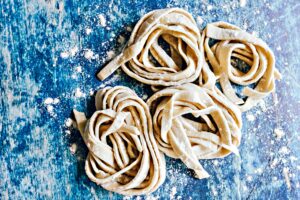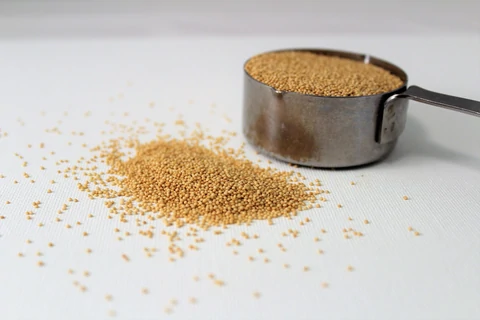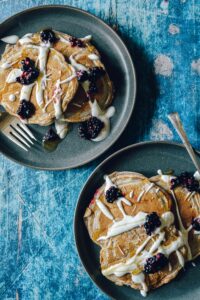
3-Ingredient Homemade Organic Kamut® Noodles
One of the most delicious things to make at home is a great pasta! Today we’re using the ancient wheat variety known as Kamut®.
Our Chef’s Guide to Gluten-Free Cooking and Baking 101
Hey everyone! My name is Stephanie Petersen, and I’ve been a professional baker for over 28 years. The advent of the gluten-free movement has been one of growth and change for many bakers. I’ve learned a lot, and I want to share some things with you on the Organic Grains Blog as their chef and recipe developer. I hope this gives you some insights to help you on your gluten-free journey.
Here are the basics.
* Oats can be found gluten-Free but must be certified to be so. Check the labels carefully.
Wheat, spelt, Einkorn, Khorasan wheat, faro, durum, and products like bulgur, farina, and semolina, contain gluten. In addition, barley, Rye, Triticale, and Oat* ( *unless certified gluten-free) contain gluten.
Gluten, a protein found in wheat flour, gives structure to baked goods. It provides bread, muffins, and cakes with a soft spongy texture. To replace gluten, you’ll need to use other thickeners like xanthan gum or guar gum in your baking. For each cup of the gluten-free flour mix, add at least one teaspoon of gluten substitute. We tend to increase the egg content as well.
Xanthan Gum
This comes from the dried cell coat of a microorganism called Xanthomonas campestris. Available in grocery stores and gluten-free sections in 2 oz bottles. It is 100% natural and mimics gluten in baking. If you have a corn or soy allergy, look for soy and corn-free brands.
Potato Starch
This gluten-free starch is an excellent thickener in soups and sauces. Mix it with a bit of water first, then substitute potato starch flour as you would cornstarch in a recipe. Half as much flour as called for to thicken.
Tapioca Starch/Flour
This is light, white, very smooth flour from the cassava root. It gives baked goods a nice chewy texture. Try it in white bread or French bread recipes. It is also easily combined with cornstarch and soy flour. A refined starch from corn is primarily used as a thickening for puddings, fruit sauces, and Asian cooking. However, it is also used in combination with other flours for baking.
Cornmeal
Cornmeal can be ground from either yellow, white, or purple (to name a few). This is often combined with flours for baking. It imparts a strong corn flavor that is delicious in pancakes, waffles, or muffins.

Amaranth was one of the staple grains of the Incas, and it is known as kiwicha in the Andes today. It’s a prolific growing plant. It is heralded as a super grain, meaning it has all the amino acids your body needs for growth in the right combination. Amaranth contains about 30% more protein than most common cereals like rice, wheat, oats, and rye! Pop it, and you’re addicted…like crack..but healthy. It’s better for you than popcorn too!
Amaranth is Gluten-free. It’s excellent cooked on the stove as a more nutritious replacement for grits. Simmer 1 part amaranth to 3 parts water on low, covered for 20-25 minutes. See the full tutorial here. A favorite is using the amaranth as grits in savory recipes like this cheese grits recipe here. When popped, amaranth makes an excellent addition to bread, cakes, and cookies. So how do you pop it? Put ¼ cup of amaranth in a hot deep pan and stir until it pops until it quadruples in size. It will make about 1 cup.
Brown Rice Flour
Made from unpolished brown rice, Brown Rice Flour retains the nutritional value of the rice bran. Use it in bread, muffins, and cookies.
Whole-grain buckwheat can cook on the stovetop in a ratio of one part buckwheat to three parts water. Simmer on low heat, covered for about thirty minutes. See the full tutorial here. Buckwheat is not related to wheat at all and is 100% gluten-free. A century ago, Russia was by far the world leader in buckwheat use. Kasha, or buckwheat groat, is a well-known use of buckwheat for pilaf come to us from our Russian friends. Unhulled buckwheat has a strong flavor, rich in iron, and a high concentration of all the amino acids, buckwheat is excellent in pancakes and great for a nice dense bread. It can be strong in flavor, so get the hulled varieties we carry here. This variety is milder in flavor and much better for those wanting to ease their family into the world of buckwheat. For bread and rolls, use up to 1 cup per recipe to impart a taste and texture that comes close to whole wheat. Use less buckwheat flour when baking delicate cookies or pies. (¼ cup contains 6 grams fiber and 5 grams protein.)
White Corn Flour
This flour is called neutral flour. It is milled from corn but is not cornstarch or cornmeal. It can be blended with cornmeal to make cornbread or muffins. It is excellent for waffles or pancakes.
This is excellent basic flour for gluten-free baking. It is milled from polished white rice. Because it has such a bland flavor, it is perfect for baking, as it doesn’t impart any flavors. It works well with other flours. The taste of the Basmati rice flour is more decadent than regular white rice flour. Organic Grains mills this flour fresh to order, so the flavor is always new.
Brown Flax Seed Meal
Brown Flax Seed Meal is high in fiber and omega-3 fatty acids. Whole flaxseed is not easily digestible, so buy a flaxseed meal (ground flaxseed) or make your own by grinding the seeds in a clean coffee grinder. Use 2 to 3 tablespoons of flaxseed meal per recipe for baked goods or sprinkle it on yogurt or cereal for a nutritional boost. Store in the refrigerator or freezer. Flaxseed meal can be soaked in warm liquid and used to replace egg in many recipes. For example, one tablespoon flaxseed meal soaked in 3 tablespoons warm liquid is equal to one egg in baking for vegans. (2 tablespoons yield 4 grams fiber and 3 grams protein.)
Garbanzo Bean ( AKA the chickpea)
This flour is high in protein, calcium, and fiber. Other bean flours additions are excellent in gluten-free baking. Varieties available as flour include bean (navy, pinto, and red) and soy. Garfava flour is a blend of flour made from garbanzo, fava, and Romano beans. Unfortunately, certain bean flours, particularly garfava and chickpea, have an aftertaste that many find unpleasant; these should be used in relatively small amounts, less than 20 percent of your recipe’s total flour blend.
To cook the whole grain, use a ratio of one part grain to three parts water. Check out our full tutorial for this process here. Simmer 35 minutes or pressure cook 6 minutes. It is most often used in America as a birdseed filler yet remarkably well-loved worldwide as “actual” people food. Millet flour has a mildly sweet, nut-like flavor. The high-protein flour is also high in fiber. For optimum results, don’t use more than 1/5 millet flour in a flour blend. (¼ cup yields 4 grams fiber and 3 grams protein.)
To cook quinoa on the stovetop, use a ratio of one part quinoa to two parts water. Simmer 20 minutes, covered on the low heat stovetop. See the full tutorial here. Pronounced Keen-wah originated in the Andean region of South America, where it was successfully domesticated about 4000 years ago. We once heard this called the great “lost grain of ancient America.” Unknowing a naturally occurring coating containing bitter saponins, We made the grain without rinsing it…only once. Because it is cooked the same way as rice, we thought the rinse was optional. However, we quickly learned that the rise was not an optional stage for the bulk quinoa. Some you can purchase in small boxes, and it says “rinsed.” If it does, then, by all means, don’t rinse. Another very nutritious option that does not require rinsing is the sprouted versions of the grain.
Quinoa comes in Black, Red, and White varieties. It can be used any way you use rice and more! It’s gluten-free and loaded with fiber. In addition, it’s a complete protein! Flour, milled from a grain native to the Andes mountains in South America, has high levels of calcium, protein, complex carbohydrates, phosphorous, iron, fiber, and B vitamins. This flour is easy to digest and has a delicate, nutty flavor like wild rice. Mix it with other flours to increase the nutritional value of your recipes but avoid using it in large quantities (no more than 25 to 30 percent of the total flour blend), as it can overpower the flavor of your baked goods. (¼ cup yields 4 grams fiber and 4 grams protein.)
Sorghum and Sorghum flour
Sorghum is available in white and red varieties with a slightly sweet taste. It is high in protein, fiber, potassium, and B vitamins. It works best when blended with other flours. Only use 30% in any flour blend for gluten-free baking should consist of sorghum. It is a darker-colored flour, so don’t use it where you want a white appearance in the finished products. Instead, use sorghum flour as an essential part of high protein blends. (¼ cup yields 3 grams fiber and 4 grams protein.)
Soy Flour
Soy flour is a nutty-tasting flour with high fat and protein content. It’s perfect when used with a combination of other flours and in brownies. Use it with fruits and nuts to help mask the beany flavor.
Teff
Teff is a grain (grass seed) that comes to us from Ethiopia. Whole seeds can be cooked on the stovetop using 1 part teff to 4 parts water. Cover over low heat and simmer 15 minutes (or pressure cooker 2 minutes). It is believed to have originated in Ethiopia around 4000 BC. In Africa, it’s been reported to have over 2000 varieties. I often use it in cookies, cakes, tortillas, and flatbreads. It is gluten-free, and it contains all the essential amino acids. It also takes 150 grains of Teff to equal the size of one grain of wheat. So it’s smaller than heck! Heck is small. So they’re small, yet they pack a nutritional punch! There is a good amount of fiber, as you can well imagine. There are 2 grams of fiber per ounce of grain (That’s almost 10% of your daily needs in one ounce, baby!). Plus, it’s a good source of iron, magnesium, phosphorus, and copper.
Use a combination of flours.
Usually, not one single flour will do the trick for avoiding dense, heavy results in baked goods. Generally plan on no more than 30% of each flour. Usually, this means no more than 1 ½ cup of each flour for every 5 cups of blended flour. The exception is chickpea and millet. They have a strong flavor and will overpower the taste of baked goods. For these, you can use a lot less, about ¾ cup for every 4 to 5 cups of the flour blend.
Store high-protein flours in airtight containers with a wide mouth so you can measure over the container.
Refrigerate all gluten-free flours. Allow refrigerated flours to return to room temperature before using them unless the recipe states otherwise. Use a wire whisk to get rid of flour clumps before you measure.
Blend well. Place in a tightly sealed container and refrigerate.
Each ¼ cup contains approx 121 calories, 1g total fat, 0g saturated fat, 0g trans fat, 0mg cholesterol, 234mg sodium, 27g carbohydrate, 2g fiber, 2g protein. Most power flours are interchangeable in equal amounts (not flaxseed meal, chickpea, or millet flour). Likewise, neutral flours are interchangeable in equal parts. Flours are not interchangeable with starches, as they have different baking properties.
Measure by weight. Mix the grain—mill on the most refined setting. If you are not generally gluten-free and are milling flour for someone who is, you may need to find out how sensitive they are to gluten. Usually, try to have one mill that is 100% gluten-free. This will keep the flour from being contaminated. For those highly sensitive to gluten, this is very important.
Use cup for cup in your baking recipes.
We Think You'll Like

One of the most delicious things to make at home is a great pasta! Today we’re using the ancient wheat variety known as Kamut®.

We’re elevating your favorite weekend pancakes with the rich and warming flavors of vanilla, blackberries and cardamom.

This recipe celebrates everything we love about summer treats. It’s creamy, dreamy, sweet and delicious.

One of the most delicious things to make at home is a great pasta! Today we’re using the ancient wheat variety known as Kamut®.

We’re elevating your favorite weekend pancakes with the rich and warming flavors of vanilla, blackberries and cardamom.

This recipe celebrates everything we love about summer treats. It’s creamy, dreamy, sweet and delicious.